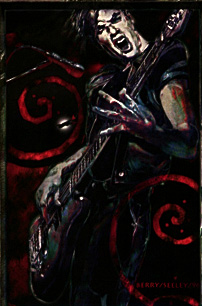

This Case, he's somebody, all right. Let his hate be a darker thing,
and let his voice cry louder--and when the world hears him, it will
believe that it is dead.
--Tezcatlipoca, Book One
The Stickman
The Stickman is Case's soul, the part of Case that he walled off during his childhood. He seems to be more than that,
however: he bears more than a superficial resemblance to the Green Man, a nature figure which has been popular in European
art for centuries, and which has again assumed spiritual significance with the current interest in neopaganism. The references
made to Osiris and Tammuz - other dying/resurrecting male figures of myth - suggest that the Stickman is in fact the embodiment
of the sacrificed god, the consort of the Goddess who dies (often willingly, or as a sacrifice) and is reborn.
Odin
Odin has many names: the All-Father, the Gallows-God, One-Eye, etc. In Norse mythology, he is the chief god,
father of Thor and blood-brother to Loki. Thor can be classified as a sky-god, although one important myth
recounts the tale of how he sacrificed an eye and hung himself by a spear from the world-tree Yggdrasil for
nine days and nights in order to gain wisdom, which gives him at least a superficial tie to the dying and resurrected
earth god (see my essay for more on this topic). Odin frequently travels in disguise, and, like most of the Norse
gods, is rather fickle. More than anything else, Odin fears Ragnarok, the prophesied doomsday battle in which
the gods and giants will slaughter one another, destroying the world in the process.
Tezcatlipoca
Aztec god of night and confusion. Tezcatlipoca was the chief rival of Quetzalcoatl; this rivalry symbolized in
myth the ethnic separation between the warlike Aztecs (Tezcatlipoca) and the conquered Toltecs (Quetzalcoatl). For
an interesting story involving Tezcatlipoca, check out the occult mystery novel Burning Water, by Mercedes
Lackey. ('Burning Water' is a possible translation of Tezcatlipoca's name; another is 'Smoking Mirror'.)
Leatherette
She's a demon. 'Nuff said.
Hephaestus
Greek god of the forge. Hephaestos was married to Aphrodite, goddess of love, who was
repulsed by his appearance and took the god Ares as lover. Hephaestos trapped the lovers
in a net while in bed together, and shamed them before the assembled gods. Here,
Hephaestos appears to have split himself into two cyborg-like bodies, in order to work more
efficiently, perhaps.
Tantalus
Tantalus was not a god, but a mortal who was doomed to never have that which he craved. The
Divine Comedy pictures him in Hell as he was seen in the Greek Underworld, standing in a
stream which moves away when he tries to drink from it, reaching for a fruit on a branch that evades
his touch. "...always wanting, and never having...."
Janus
Two-faced Roman god. Despite the popular connotation of 'two-faced', Janus can be considered a god of knowledge
and foresight, able to look (literally) in two directions at once. Stone heads of a Janus-like aspects were also
popular among the pre-Christian Celts, perhaps as ritual items.
Coatlicue
Aztec mother goddess. As you can tell from her portrayal in Mythos, she's got a strong connection
with snakes (note that 'coatl' also appears in the name of the god Quetzalcoatl). Coatlicue lived in a
volcano, and was revered in Aztec myth as the mother of the gods.
Straccio/Enna
Apparently a god of pestilence, originally Babylonian. The name 'Straccio' may be an affectation due to
current residency in Italy, or simply egotism. No other available information.
Yuki-Onna
No information on Yuki-Onna, other than to note that she is apparently a Japanese deity ('onna' is Japanese
for 'woman').
Desire
Desire is one of the Endless, the seven personifications of creation who are not gods, and who will outlive
the gods. The others are Destiny, Death, Dream, Destruction, Despair, and Delirium. For more on Desire,
consult Neil Gaiman's series The Sandman, which centers around Dream but includes other members of
his family at times.
The Mother
This is a nonspecific manifestation of the mother goddess who is common to pre-Christian (and post-Christian) mythology
around the world. She exhibits here characteristics which can be identified, I think, more strongly with the mother-goddess
images put forth by the modern revivals and recreations than with anything in ancient myth: she cares for Case, is concerned about
his situation, but recognizes that ultimately the responsibility for change rests in his hands, not hers.
John Constantine
Constantine is a perennial figure in the Vertigo universe. He has his own series, Hellblazer, and has in addition
appeared in The Sandman, The Books of Magic, and Swamp Thing. I don't read
Hellblazer, but from what I've seen of Constantine in other venues, it seems that he's a sort of occult troubleshooter,
keeping the world safe from dangerous incursions of uncontrolled or destructive magic. He smokes a lot, and is frequently seen wearing a
trench coat.
Check out my list of pagan rock bands for a listing of bands who make music in a pagan context.
For a different tale about myth, magic, and rock music, read Gael Baudino's Gossamer Axe.
Information about John Ney Reiber's other work can be found at these sites:
If you liked this book, you might be interested in other DC/Vertigo titles.